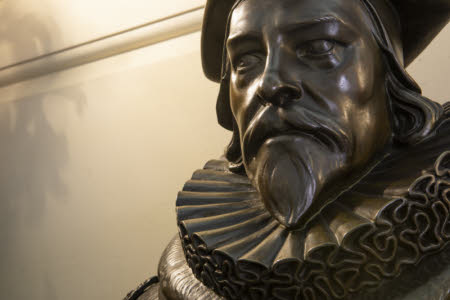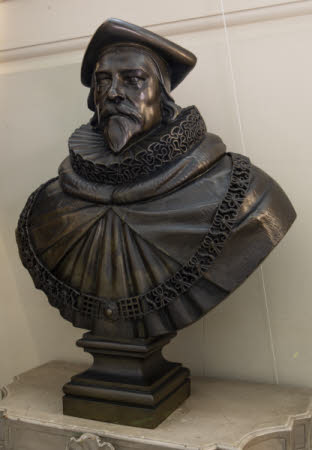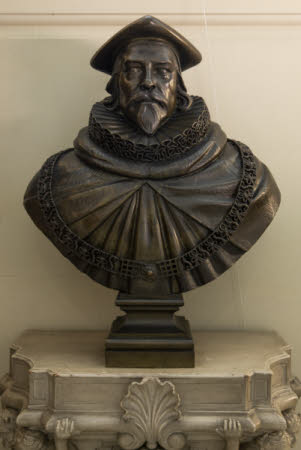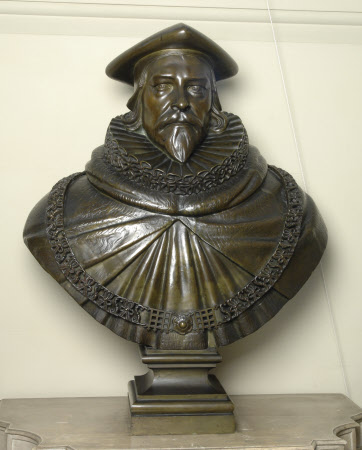Portrait bust of Sir John Bankes MP PC (1589-1644)
Baron Carlo Marochetti, RA (Turin 1805 – Passy, Paris 1867)
Category
Art / Sculpture
Date
c. 1839 - 1841
Materials
Bronze
Measurements
850 mm (33 1/2 in)
Place of origin
Paris
Order this imageCollection
Kingston Lacy Estate, Dorset
NT 1255240.1
Summary
Sculpture, bronze; portrait of Sir John Bankes; Carlo Marochetti (1805-1867); c. 1839-41. A bronze portrait bust of Sir John Bankes, Attorney-General to King Charles I, founder of the Bankes family’s fortunes and the purchaser of the Corfe and Kingston Lacy estates n the 1630s. The bust was one of two of Sir John that William Bankes commissioned, as part of his early plans for the transformation of Kingston Lacy, which originally envisaged a series of busts of ancestors. It is heavily dependent on a portrait bust of the lawyer Sir Thomas Richardson (1569-1635) in Westminster Abbey, a plaster cast of which was sent to the sculptor Carlo Marochetti, to serve as a model for the sitter’s dress.
Full description
A bronze portrait bust of Sir John Bankes (1589-1644) by Carlo Marochetti (1805-1867). The subject is depicted frontally, with a small pointed beard, dressed in judge’s robes and with a large ruff at his neck. On his head are a skull-cap over which is a cap. He wears the chain of office of the Chief Justice of the Common Pleas, a gold chain of esses (S’s). On an integral rectangular stepped socle. A pair to the second bronze portrait bust of Sir John by Marochetti (NT 1255240.2), which is all but identical, except that it depicts the sitter wearing just the skull cap. Sir John Bankes was the first member of the Bankes family to play an important role in national life, and the founder of the family’s fortunes. From a Cumberland family, the young John Bankes entered Gray’s Inn in 1607 and was called to the Bar in 1614. In the 1620’s Bankes entered Parliament, firstly as MP for Wootton Bassett and then for Morpeth. It was in the 1630s that his career took off, with his appointment in 1630 as Attorney-General to the young prince Charles (later king Charles II) and in 1634 to king Charles I himself. Bankes was knighted by Charles in the same year. In 1635 he bought the ancient castle of Corfe and a year later completed his purchase of the Kingston Lacy estate. In 1641, just before the outbreak of the Civil War, Sir John was promoted to Chief Justice of the Common Pleas. During the turmoil of the following years, Bankes remained a valuable mediator between the monarch and Parliament until 1643. A loyal supporter of the king, he spent his last years, from 1642, with the court in exile in Oxford, where he died in 1644. Whilst he was in Oxford, Sir John’s wife Lady Mary remained at Corfe Castle, which she bravely defended during two sieges by Parliamentary forces in 1643 and 1646, only eventually surrendering the castle as a result of treachery. The two bronze portrait busts of Sir John Bankes were commissioned by William John Bankes from the Italian sculptor Carlo Marochetti (1805-1867), for a series of portrait busts of ancestors in the entrance hall at Kingston Lacy, envisaged in the early stages of Charles Barry’s renovations undertaken between 1836 and 1840. In 1839, Bankes ordered the sculptor William Nainby to take casts from the portrait bust by Hubert Le Sueur (c. 1580-1658) that forms part of the monument to Sir Thomas Richardson, in Westminster Abbey. Richardson had also served as Chief Justice of the Common Pleas, between 1626 and 1631. Bankes evidently realised that he needed to provide Marochetti with a suitable model of contemporary legal dress; having attended Westminster school and with his London home in Old Palace Yard, next to the Abbey, he would have known Westminster Abbey and its furnishings very well. Of the two casts made by Nainby and billed to Bankes in October 1839, one was sent to the sculptor, then living in Paris, whilst the other was dispatched to Kingston Lacy, where it survives (NT 1257612). Carlo Marochetti, although less well-known today, was in the 1830s and 1840s regarded as one of the finest contemporary sculptors working in Europe, especially after the triumph of his equestrian statue of Emmanuele Filiberto of Savoy, which had been exhibited at the Louvre before being permanently installed in the Piazza San Carlo in Turin, in 1838. This dashing and dramatic monument in the full romantic style established the reputation of Marochetti and must have convinced Bankes, among others, that he would make the ideal sculptor for historical works. Marochetti, who moved to Britain after the revolution of 1848, would indeed go on to make another major equestrian monument, the statue of Richard the Lionheart, the bronze version of which was installed outside the Palace of Westminster in 1860. His numerous other works included an equestrian statue of the Duke of Wellington for Glasgow, installed in 1844, whilst Marochetti also cast the massive bronze lions designed by Sir Edwin Landseer for the base of Nelson’s Column in Trafalgar Square. William Bankes much admired the work of Carlo Marochetti, eventually commissioning several works from him for Kingston Lacy, notably the magnificent full-length statues of Sir John and Lady Bankes, sited on the staircase Loggia between the seated figure of king Charles I (NT 1255195.1-3). It is not known when Bankes and Marochetti first met, but it was probably in the later 1830s, around the time of Marochetti’s great success with the monument to Emmanuele Filiberto. Bankes was outspoken in his enthusiasm for Continental art, declaring in evidence to a Parliamentary Select Committee on the Fine Arts that he felt himself to be on a mission to promote, within his own country, bronze sculpture as it was practised in Paris. He would become an active and vociferous supporter of Carlo Marochetti’s bid in 1840-41 for the commission to make the equestrian statue of the Duke of Wellington for the city of Glasgow. The bronze statuette at Kingston Lacy (NT 1255215) of the historian Carlo Botta (1766-1837), a close family friend of Marochetti, was one of several small bronze sculptures by the artist sent to Glasgow, to demonstrate to the selection committee Marochetti’s skills in the modelling and casting of bronze sculptures. The making of the two busts of Sir John Bankes is much less well-documented than are some of Bankes’s other commissions to Marochetti. Nevertheless, the evidence of the taking of the plaster cast of the Richardson bust, as well as references in the two men’s correspondence in the early months of 1841 (just before William Bankes’s hurried flight into exile), would strongly suggest that they were made in 1840-41, rather than in the 1850s, when Bankes and Marochetti resumed contact after a gap of some twelve years and work proceeded on the three statues for the Loggia. In a letter of 27 April 1841 (Dorset History Centre, Bankes Papers, D-BKL/H/J/1/605), Marochetti wrote that he had had a cast taken from a statue of Anne of Austria (the bronze figure by Simon Guillain from the Pont au Change in Paris, now in the Musée du Louvre). He would on his return to Paris make the bust that Bankes wanted and would send him a proof so that, once Bankes had approved the model, it could be cast in bronze. Whilst this seems to relate to a planned bust of Lady Bankes, which was never made, it demonstrates how at this time William Bankes still planned to create a series of portrait busts of his ancestors. It seems very likely that the bronze portrait bust at Kingston Lacy of king Charles I (NT 1255241), with whom the Bankes family’s fortunes during the Civil War were so entwined, also formed part of this planned series, as did one or both of the bronze busts of Sir John Bankes. In a subsequent letter of 10 May (D-BKL/H/J/1/608), Marochetti wrote to William Bankes firstly of the bust of Anne of Austria, but then added, ‘I will not bring either the portrait of your ancestor, because I will need it if we succeed in carrying out the project we have discussed.’ (‘je n’apporterai pas non plus le portrait de votre ancêtre parceque j’en aurai besoin si nous executons le projet conçu.’). It is not known what image was sent to Marochetti to serve as a model for the portrait of Sir John Bankes, in addition to the plaster bust of Sir Thomas Richardson. It is though the Le Sueur model that predominates in Marochetti’s finished portrait bust which, in the costume and to a great extent in the face of the sitter, is in fact effectively copied from Le Sueur. It is not known what images of Sir John Bankes were sent to Marochetti to serve as models for the portrait, in addition to the plaster bust of Sir Thomas Richardson. It is the Le Sueur model though that predominates in Marochetti’s finished portrait bust which, in the costume and to a great extent in the face of the sitter, is simply copied from Le Sueur’s image. Marochetti has made an attempt to enliven the portrait, by showing the sitter looking sharply to his right, but overall both the busts of Sir John are rather stiff and old-fashioned images, a world away from the portrait bust of an unknown man made in Rome in the 1640s, also at Kingston Lacy (NT 1257591) and once also thought to be Sir John Bankes. This lively Baroque work was made just a few years after Le Sueur’s altogether more old-fashioned portrait of Sir Thomas Richardson. As Charles Avery wrote in his commentary on the Richardson bust: ‘its frontality, emphasized by the rigid symmetry of the cap, ruff and robes of a Judge, makes it look archaic, as though it were an image of a Tudor worthy made a century earlier.’ (Avery 1982, pp. 163-64) Jeremy Warren January 2024
Provenance
Commissioned by William John Bankes, c. 1839-40; by descent to Ralph Bankes (1902-1981), by whom bequeathed in 1981.
Makers and roles
Baron Carlo Marochetti, RA (Turin 1805 – Passy, Paris 1867), sculptor
References
Avery 1982: Charles Avery, 'Hubert Le Sueur, the 'unworthy Praxiteles' of King Charles I', The Walpole Society, Vol. 48 (1980-82), pp. 135-209 Ward-Jackson 1990 Philip Ward-Jackson, “Expiatory monuments by Carlo Marochetti in Dorset and the Isle of Wight” Journal of the Warburg and Courtauld Institutes, Vol. 53,1990, pp.266-280, p. 270, Pl. 32b. Roscoe 2009: I. Roscoe, E. Hardy and M. G. Sullivan, A Biographical Dictionary of Sculptors in Britain 1660-1851, New Haven and Yale 2009, p. 806, no. 87.




